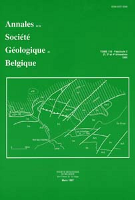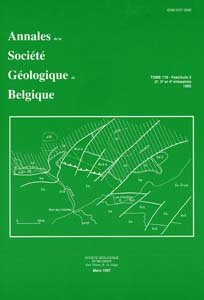- Accueil
- Volume 105 (1982)
- Fascicule 2
- Factors controlling the distribution of Chitinozoa in the Gleedon chronozone (Wenlockian) of northern Europe
Visualisation(s): 246 (9 ULiège)
Téléchargement(s): 93 (1 ULiège)
Factors controlling the distribution of Chitinozoa in the Gleedon chronozone (Wenlockian) of northern Europe

Résumé
Nous avons voulu ici contrôler la répartition des Chitinozoaires suivant un même horizon chronostratigraphique en Europe occidentale, en l'occurrence la transition entre deux zones à graptolithes du Wenlockien-Gleedon : z. à Gothograptus nassa et z. à Monograptus ludensis. Nous pensons ainsi pouvoir évaluer l'influence du provincialisme d'une part et celle du milieu local d'autre part, sur la composition des assemblages. Nous avons soumis un ensemble de données analytiques, de variables paléontologiques et de paramètres physico-chimiques à l'analyse factorielle Q et R. Il ne s'en dégage aucune intervention marquante du provincialisme, milieu et mode de vie étant les facteurs prédominants. Conochitina voit sa distribution liée aux conditions du fond marin et était donc probablement benthique. Linochitina, Ancyrochitina et Sphaerochitina paraissent indépendants du milieu de sédimentation et étaient sans doute planctoniques. Enrichissement en Linochitina et transgression marine paraissent aller de pair.
Abstract
Samples were collected along a chronohorizon defined by the transition between the Wenlockian (Gleedon Chronozone) graptolite zones of Gothograptus nassa and Monograptus ludensis in several northern European localities to evaluate the influence of large scale provincialism and local habitat on the distribution of Chitinozoa. The distribution of Chitinozoa and several environmental parameters based on a number of palaeontological, chemical and physical variables were submitted to Q- and R-mode factor analyses. Provincialism does not seem to influence the distribution of Chitinozoa in the localities considered. The distribution of Conochitina is controlled by physicochemical factors related to bottom conditions; from this a benthonic habitat can be inferred. The distribution of Linochitina, Ancyrochitina and Sphaerochitina appears to be controlled by biological factors, independent of bottom conditions and thus indicating a planktonic habitat. The increase of Linochitina forms in a stratigraphic column is shown to represent a transgressive trend.





